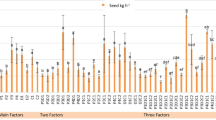Abstract
Thirty-six lots of eightCuphea species grown at nine geographical locations from 1983 to 1985 were analyzed for seed weight, oil percentage, fatty acid and crude protein content. Twenty-two samples were separated into two distinct seed maturity groups and also analyzed. Seed maturity varied widely but had little effect on oil percentage, even though mature seeds were significantly heavier than less mature seeds. Lauric acid content generally increased and capric acid decreased with increasing seed maturity. Crude protein of whole seeds and defatted seed meal increased with increasing seed maturity. The net effect of harvestingCuphea wrightii seeds at full maturity in comparison with that for less mature seeds was to increase seed weight by 12%, decrease capric acid by 3%, increase lauric acid by 2% and increase crude protein of whole seeds and defatted meal by 5% and 4%, respectively. Seed oil content was decreased by a statistically nonsignificant 1%. The effect of seed maturity was comparable for the other four lauric acid- and three capric acid-rich species, even though distinct species differences in all factors were measured. Location and environment contributed to some quantitative and qualitative changes, but these factors are not considered to be major sources of variation. It is concluded that variation in seed maturity does not present a major constraint to commercialization ofCuphea as a new, alternative source of lauric and other medium-chain fatty acids. The ultimate significance of these minor changes will depend upon relative yields, demands and values of the various seed components.
Similar content being viewed by others
References
Babayan, V.K.,J. Am. Oil Chem. Soc. 58:49A (1981).
Bach, A.C., and V.K. Babayan,Am. J. Clin. Nutr. 36:950 (1982).
Miller, R.W., F.R. Earle, I.A. Wolff, and Q. Jones,J. Am. Oil Chem. Soc. 41:279 (1964).
Graham, S.A., F. Hirsinger, and G. Röbbelen,Am. J. Bot. 68:908 (1981).
Wolf, R.B., S.A. Graham, and R. Kleiman,J. Am. Oil Chem. Soc. 60:27 (1983).
Graham, S.A., and R. Kleiman, Ibid.:81 (1985).
Hirsinger, F.,Angew. Botanik 54:157 (1980).
Hirsinger, F.,Fette, Seifen, Anstrichm. 82:385 (1980).
Röbbelen, G., and F. Hirsinger, inImprovement of oil seeds and industrial crops, International Atomic Energy Agency, Vienna, Austria, 1982, p. 161.
Thompson, A.E.,HortScience 19:352 (1984).
Thompson, A.E.Econ. Bot. 39:436 (1985).
Hirsinger, F., and P.F. Knowles, Ibid.:439 (1984).
Hirsinger, F.J.,Am. Oil. Chem. Soc. 62:76 (1985).
Stubbs, J.M., and A.R. Slabas,Planta 155:392 (1982).
Official Methods of Analysis, Association of Official Analytical Chemists, 1984, p. 16.
Author information
Authors and Affiliations
About this article
Cite this article
Thompson, A.E., Kleiman, R. Effect of seed maturity on seed oil, fatty acid and crude protein content of eightCuphea species. J Am Oil Chem Soc 65, 139–146 (1988). https://doi.org/10.1007/BF02542566
Received:
Issue Date:
DOI: https://doi.org/10.1007/BF02542566



